
How Much Does Facebook Advertising Cost? (UK, US, India & More)
So how much does Facebook advertising cost?
I’m asked this question all the time.
Which makes sense…
When you’re talking to a Facebook advertising expert, one of the things you naturally want to know is the cost of Facebook advertising.
Of course, the really annoying and predictable answer is…
It depends.
(Don’t worry you’re not wasting your time reading this article – I’m going to give a far more useful answer than that.)
But most of the time is does depend.
Are you a solopreneur looking to generate $50k of revenue per year?
Or a much larger company that needs to generate millions in additional revenue to make Facebook advertising worth the effort?
I’ve used quite extreme examples here to make a point.
How much Facebook advertising costs you, depends on a number of factors that I’m going to get to.
However, it is very helpful to understand the averages…
Average Facebook Advertising Cost By Country
On average Facebook advertising costs $0.97 per click (CPC). However, this varies between countries. For example, in the UK average cost per click is £0.78 (Hubspot). Whereas in the US it’s $1.10 (AdEspresso).
The UK and the US are similar markets, so the CPC does not differ very much. In far less expensive markets like India, the average cost per click on Facebook is just $0.12 (eMarketer).
Here’s a graph that shows average cost per click by country on Facebook for Q4 2017 (Facebook ads cost hasn’t changed much since):
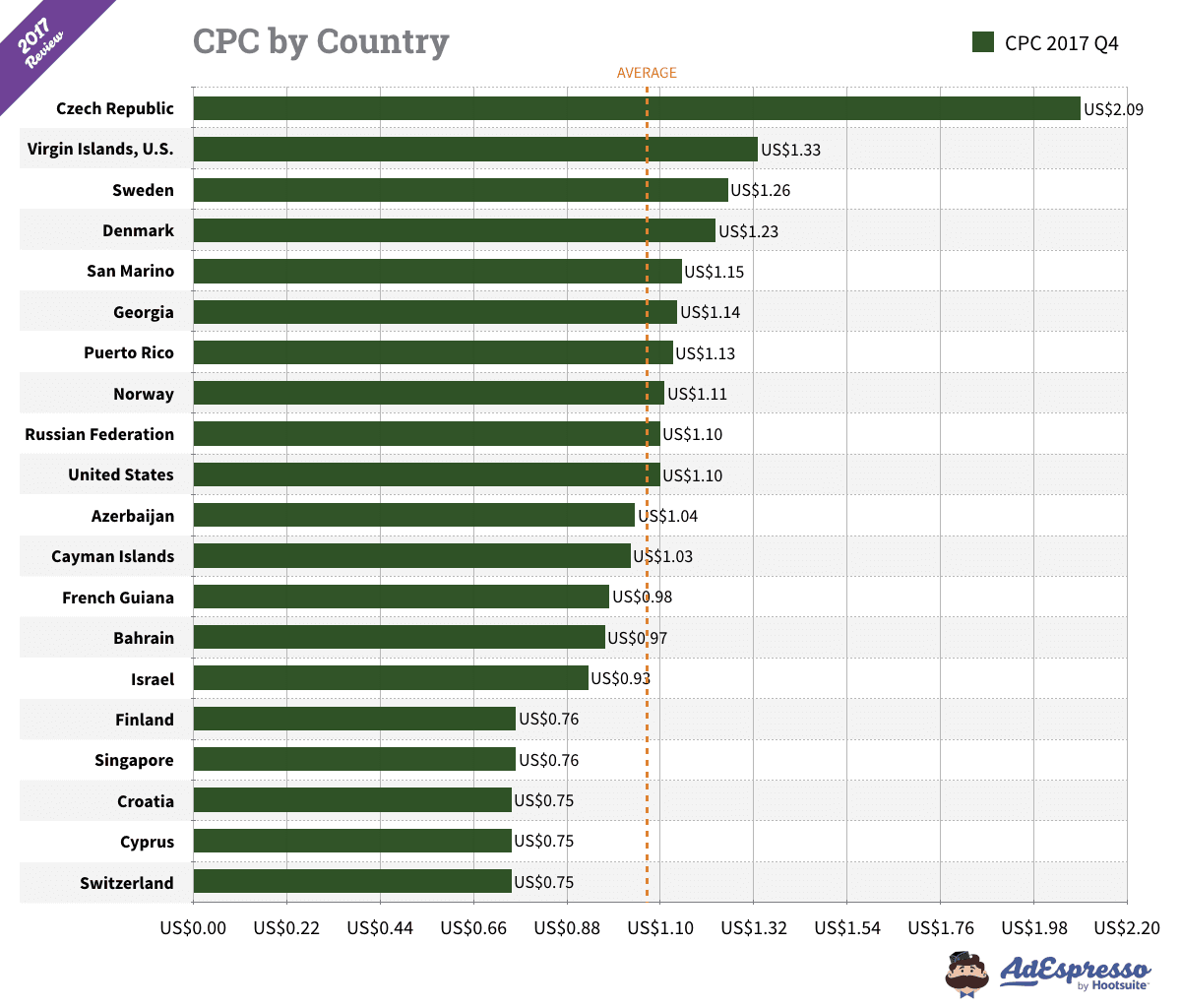
(Image source: AdEspresso)
Whilst advertisers may predominantly measure cost per click or cost per conversion, that’s not how Facebook charges its advertisers.
Facebook cares a lot more about cost per thousand impressions (CPM).
Facebook CPMs also vary between country, but don’t necessarily match the relative CPCs.
In the US, average CPM on Facebook is $7.34 (AdEspresso). But in the UK, average CPM is just $3.15 (Statista).
Between the UK and the US there is much smaller difference between CPC than CPM.
This means that Facebook advertising cost in the UK is considerably less, on an impression basis, than in the US. But US advertisers achieve much higher click-through rates (CTR).
[feature_box style=”10″ only_advanced=”There%20are%20no%20title%20options%20for%20the%20choosen%20style” alignment=”center”]
IMPORTANT: If you haven’t yet seen my FREE training on Facebook Ads Strategy, I’d strongly recommend you check it out right now:
3 Killer Facebook Ads Strategies To Double (Or More!) Your Revenue!
In it, I demonstrate 3 Facebook Advertising sales funnels that I’ve used to generate 7+ figures repeatedly for our clients.
If you want better results from Facebook – this is a must watch!
[/feature_box]
What Affects Facebook Advertising Cost?
Click-Through Rates (CTR)
If you’re primarily measuring CPC, the click-through rates (CTR) that your campaigns achieve will have a big impact on your overall Facebook advertising cost.
Here’s an example:
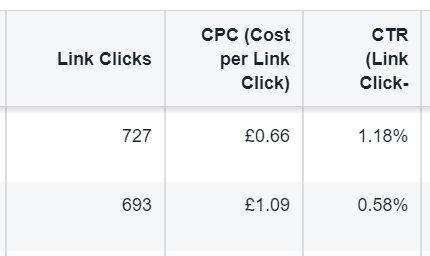
Both of the ads you can see above have generated around 700 link clicks.
The first ad achieved a CTR of 1.18% and as a result a cost per click of £0.66.
The second ad achieved a much lower CTR of 0.58% and a result, clicks cost almost double at £1.09 each.
As I mentioned previously, Facebook charges on a CPM basis. If you generate twice as many clicks from the same number of impressions, you’ll halve your CPC.
Here are the CTR averages for a number of industries:
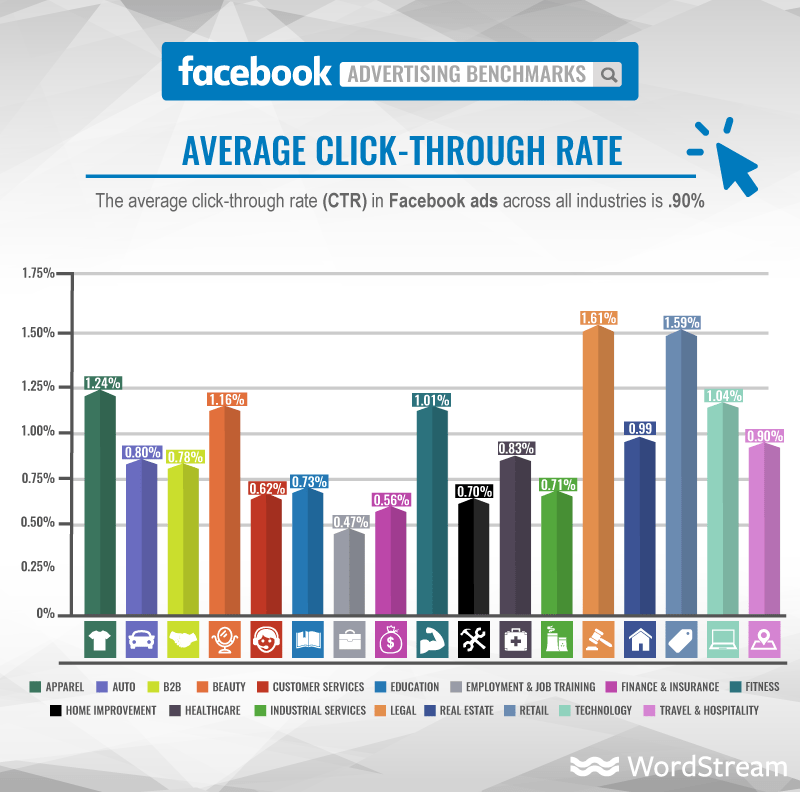
(Image Source: Wordstream)
Ad Relevance Score
Once an ad has received at least 500 impressions, Facebook will generate an ad relevance score for it.
This is a number from 1-10 that shows how well your Facebook ads are being received by your target audience.
The higher the score, the better.
And this is a big factor in determining your Facebook advertising cost. I’ll explain why…
Facebook want to ensure that their social media platform is not ruined by advertisers.
They want advertisers to create ads that their users will enjoy (or at least tolerate). Because if they don’t, users will get annoyed and potentially leave the platform.
Facebook takes this very seriously and in addition to their advertiser policies, they reward ads that achieve high relevance scores with lower CPMs.
And punish ads that have low relevance scores, with higher CPMs.
They even factor in your landing page experience, which is why I recommend all Facebook advertisers use a tool like ClickFunnels (aff. link) to create high quality landing pages.
Here’s a short video that explains Facebook’s ad relevance score in more detail:
Ad relevance score is determined using positive and negative feedback, CTR and engagement rates (comments, likes and shares).
There are a number of different ways to improve your ads and make them more engaging, many of which I cover in this Facebook advertising tips article.
One of the most effective, is simply to use Facebook video ads where possible.
UPDATE: Facebook’s relevance score has been replaced with 3 metrics called:
- Quality Ranking
- Engagement Rate Ranking
- Conversions Rate Ranking
These three metrics are the main component parts of the relevance score and work in exactly the same way.
[feature_box style=”8″ only_advanced=”There%20are%20no%20title%20options%20for%20the%20choosen%20style” alignment=”center”]
Interested in our Facebook advertising services?
To find out more you can book a free 30-minute strategy with Ben Heath (our CEO) here.
[/feature_box]
Facebook Ad Objectives
When you create a Facebook ad campaign, one of the first things you need to decide is your ad objective.
Here’s the current list of options:
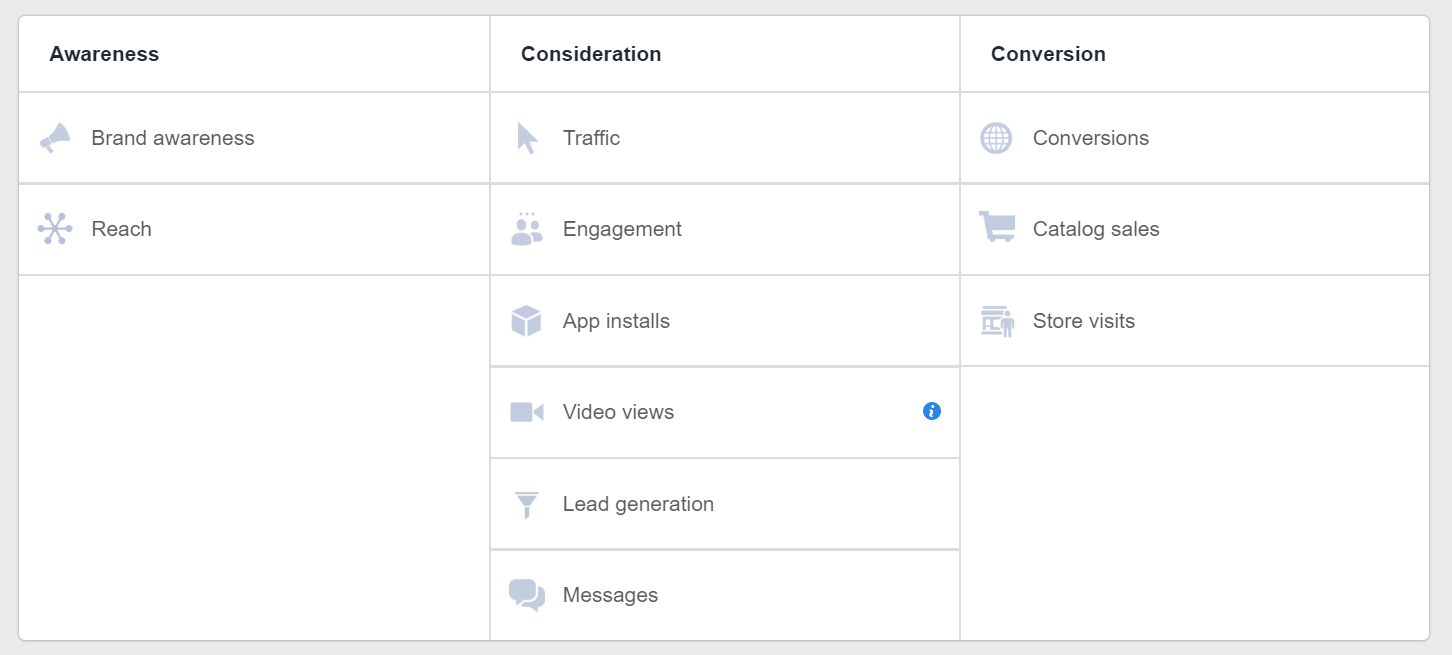
Which option you select has an impact on your Facebook advertising cost.
If you select the conversions objective for example, you will almost certainly pay more than if you select the reach objective.
That’s because with this campaign objective, Facebook will put your ad in front of people that are most likely to convert. And these people may not be the cheapest to advertise to.
That said, you still want to select the campaign objective that best describes what you’re looking for.
Whilst CPM and CPC may be higher with the example above, your cost per conversion should be lower.
(Which is probably what you really care about!)
Not familiar with Facebook’s campaign objectives and what they mean?
Check out this video for details on each campaign objective and when you want to use each:
Target Audience
Who you target with your ad campaigns can also have a big impact on Facebook advertising cost.
Certain demographics are more financially valuable to advertisers than others.
And as Facebook advertising works through an automated bidding system, the more valuable an audience is, the more people will be willing to pay to advertise to it, and the more expensive it becomes.
The most obvious example of this is income targeting:
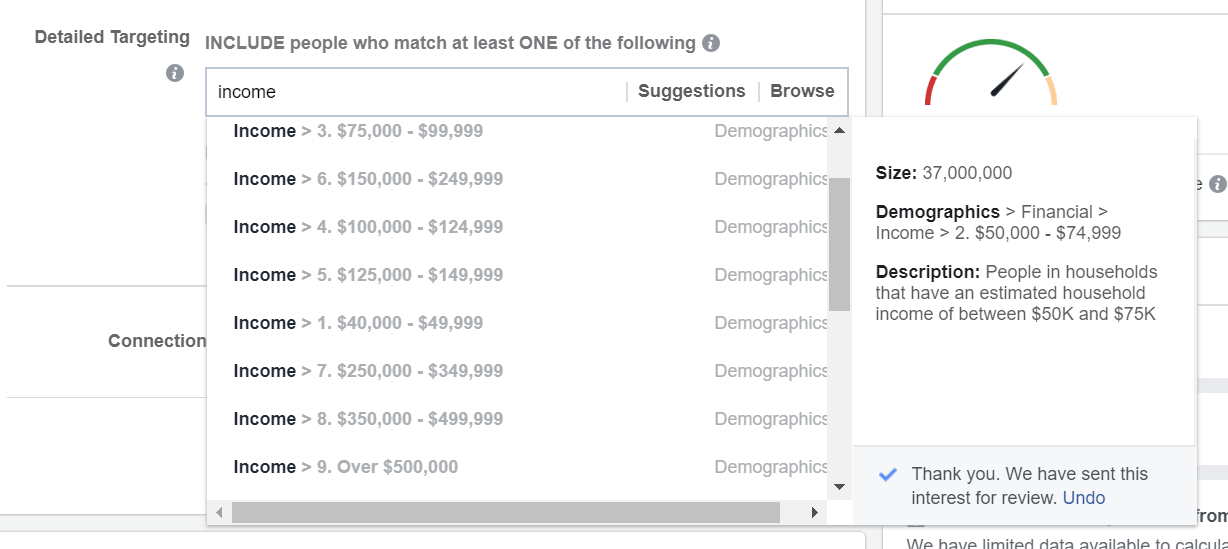
It’s not surprising that people with higher incomes are more expensive to advertise to.
These people are wealthier and can spend more money on products and services. Therefore advertisers are willing, and able, to pay more to reach them.
There are of course many other examples of audiences that are more expensive to reach than others. And if your target audience is expensive to advertise to there’s not much you can do about that.
However, it is important to be very specific with your targeting options. You don’t want to waste money advertising to people that are never going to become customers.
For step-by-step instructions on how to find awesome Facebook targeting options for your business, check out this video:
The Industry You’re In
It turns out there are quite significant differences in Facebook advertising cost between industries.

(Image source: Wordstream)
A lot of this data is unsurprising. The most expensive industry in the list above is Finance and Insurance which averages $3.77 per click.
Apparel on the other hand, is the lowest at just $0.45.
Most people are a lot more interested in apparel than they are in finance and insurance.
And as someone who creates Facebook ad campaigns for clients, it would be a lot easier to create interesting and engaging ads for an apparel brand, than for an insurance company.
There’s not a lot you can do about this as a Facebook advertiser.
If you operate in a more expensive industry you just have to accept that and make sure you don’t beat yourself up if your CPCs are high.
Fortunately, industries such as finance and insurance have high average customer values, so they can justify the added expense.
[feature_box style=”10″ only_advanced=”There%20are%20no%20title%20options%20for%20the%20choosen%20style” alignment=”center”]
FREE TRAINING: 3 Killer Facebook Ads Strategies To Double (Or More!) Your Revenue!
In this free training, I demonstrate 3 Facebook Advertising sales funnels that I’ve used to generate 7+ figures repeatedly for our clients.
Because it doesn’t matter how specific your targeting is, or how engaging your ad creative is – if you don’t have the right strategy for YOUR products and services – your campaigns are very unlikely to succeed.
[/feature_box]
Facebook Ad Placement
Unsurprisingly Facebook advertising cost varies significantly between placements.
Facebook ad placements refers to the locations in Facebook and Instagram in which your ads may be displayed.
Some placements are much more sought after than others because they usually perform better.
As a result, they carry a premium.
Here’s a video that explains the difference between the various placement options:
Ad Creative
When it comes to improving Facebook ad performance, most people focus on targeting, delivery, etc.
But the single most important part of a Facebook ad campaign has been, and always will be, the ad itself.
Remember, your ad is the only part of your campaign that your prospect sees.
It either grabs their attention and convinces them to take the action you want them to take… or it doesn’t.
The quality of your ad creative can have a massive impact on how much your Facebook ads cost. Both in terms of cost per click and cost per conversion.
If you to know how to create high-converting and engaging Facebook ads, you should check out this video:
Facebook Ad Budget
Now that you have an idea of what Facebook ads should be costing you, given your industry and the country you’re in.
And you know some of the major factors that affect Facebook advertising cost.
It’s time to talk about budgets…
Starting Budget
If you’re hoping to significantly grow your business with a $5 per day Facebook advertising budget…
I’ve got bad news for you…
It’s very unlikely to happen.
Facebook ads can deliver a fantastic ROI, but even a 10x ROAS (return on ad spend) only generates $50 a day with that budget.
It can take a lot of work to create a profitable Facebook advertising sales funnel.
If the pay off at the end is only $50 a day – that’s just not worth it.
In my opinion, if you don’t have $10 per day to invest in Facebook advertising then you should focus your attention elsewhere.
You can always come back to it when you’ve accumulated a bit more capital.
So if $10 per day is the minimum, what should you start with?
$10 per Day
If you have the luxury of time (no upcoming product launch or additional overheads to cover) then why not start with just $10 per day?
One of the best things about digital marketing and Facebook advertising in particular, is it’s scalability.
Once you’re generating a great ROI at $10 per day, you can increase your budget to $100, $1,000 or even $10,000 per day.
But before that (and whilst you test) you can minimise your risk.
This approach does take longer and requires more patience than I have.
During the early stages of Facebook advertising you’ll need to test different ad headlines, images, targeting options and even the offers you make, to determine which works best.
Testing takes time and testing with a small budget takes longer.
The more you spend, the faster you’ll generate results and the faster you’ll test your way to a profitable Facebook advertising sales funnel.
If you’re like me and you want to generate results as quickly as possible, then by all means start with a larger budget.
But unless your company does more than 7 figures a year, I wouldn’t start with more than…
$1,000 per Day
With Facebook advertising, it’s easier to generate a great ROI with smaller budgets.
And that’s because with a larger budget you’ll advertise to larger audiences.
By definition, larger audiences are less targeted than smaller audiences and produce a lower ROI as a result.
That doesn’t mean you can’t scale once your campaigns are ROI-ing.
But unless you’re on a tight deadline (product launch, etc.) I wouldn’t start testing with more than $1,000 per day.
$10 – $1,000 per day is obviously a very wide range, but that’s reflective of the wide range of businesses that will start advertising on Facebook.
The idea is to start with something that’s affordable for your business, but enough to make it meaningful.
Once You’re Up & Running…
Once you’ve tested (small or otherwise) and you have a Facebook advertising sales funnel that’s generating a great ROI…
It really does depend.
The major factor in determining your Facebook advertising budget is your business and it’s objectives.
How big is your company to begin with?
How ambitious are you?
Are you able to scale?
How much spare capacity do you have?
The questions go on and on.
Fortunately I’ve written a blog post all about how to set your Facebook ad budget. Which shows you how to work backwards from your objectives and come up with a reasonable ad budget.
Conclusion
Your Facebook advertising cost depends on a number of factors including:
- The country you’re advertising in
- Click-through rate (CTR)
- Ad relevance score
- Facebook ad objective
- Target audience
- The industry you’re in
- Placement option
- Ad creative
Once you understand the factors that affect cost, you can go about reducing it.
In some circumstances there is only so much you can do, but you can always get an edge on your competition.
For more information on how to do that, check out this article: 47 Facebook Advertising Tips for Success in 2021
What do you think? Let me know in the comments below…



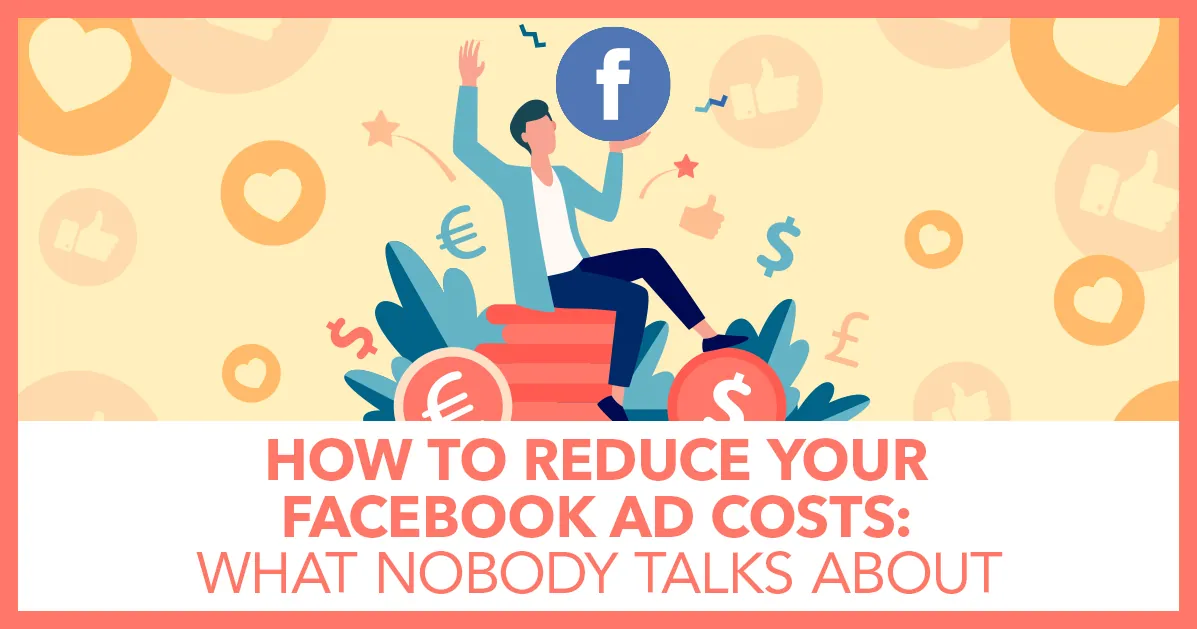
Sorry, the comment form is closed at this time.